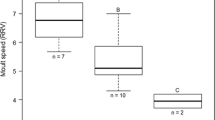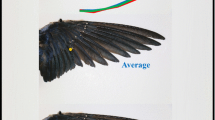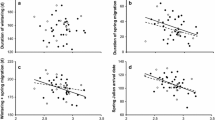Abstract
Wing moult is a critical period within the annual cycle of birds, particularly in waterbirds which become completely flightless. The inherent vulnerability to anthropogenic disturbance, predation and decreasing habitat quality often results in remarkable body weight loss. However, moult-related changes in body weight can be explained by two hypotheses: The ‘adaptive weight loss’ hypothesis suggests that the reduction of body weight is a special adaptation to flightlessness, whereas the ‘environmental constraint’ hypothesis suggests that weight dynamics mainly depend on local environmental conditions. To assess these two scenarios, weight changes of moulting Gadwalls (Anas strepera) were measured during 9 study years. We also analysed the effect of sex-specific differences in timing of moult and previous reproductive investment. Over all years, flightless males lost on average 3.9 % and females 10.6 % of body weight, yet both sexes recovered weight towards the end of moult. In single years, male weight significantly decreased during only 1 out of 9 and female weight during 3 out of 8 moulting seasons. Only female weight dynamics changed considerably among and within these seasons. In particular, females were significantly lighter when moulting late, a trait that is characteristic of successful breeders. Lower average weight levels of moulting females following breeding seasons of higher reproductive output further highlight the connectivity of these consecutive life history stages. Overall, our data indicate that moult-related changes in body weight result from environmental circumstances, rather than being an adaptation to the flightless stage per se. Appropriate moulting sites should be created and protected because adverse habitat conditions during moult could have direct as well as long-lasting fitness-relevant effects on waterbirds.
Zusammenfassung
Wasservögel können unter guten Umweltbedingungen auch ohne Gewichtsverlust mausern: eine Fallstudie an Schnatterenten ( Anas strepera )
Die Zeit der Schwingenmauser ist eine kritische Phase im Jahreszyklus der Vögel. Dies gilt besonders für Wasservögel, die vollständig flugunfähig werden. Die resultierende Anfälligkeit gegenüber anthropogenen Störungen, Prädation und sinkender Habitatgüte ist oft mit einem Verlust an Körpergewicht verbunden. Gewichtsschwankungen während der Schwingenmauser können jedoch durch zwei unterschiedliche Hypothesen erklärt werden: Die „Adaptive Weight Loss“Hypothese interpretiert, dass der Gewichtsverlust eine spezielle Anpassung an die Flugunfähigkeit darstellt. Die „Environmental Constraint“Hypothese schlägt dagegen vor, dass die Gewichtsentwicklung hauptsächlich von den lokalen Umweltbedingungen abhängt. Wir haben die Gewichtsschwankungen mausernder Schnatterenten (Anas strepera) über neun Studienjahre hinweg untersucht und können damit zur Bewertung dieser beiden Hypothesen beitragen. Außerdem wurde der Effekt geschlechtsspezifische Unterschiede in der zeitlichen Koordinierung der Mauser und der Investition in die vorausgehende Reproduktion analysiert. Über alle Jahre gemittelt verloren flugunfähige Männchen 3,9 % und Weibchen 10,6 % des Körpergewichts. Beide Geschlechter konnten diesen Gewichtsverlust bis zum Ende der Mauser wieder ausgleichen. In einzelnen Studienjahren zeigte sich allerdings ein abweichender Verlauf. Ein signifikanter Gewichtsverlust konnte bei Männchen nur in 1 von 9 und bei Weibchen nur in 3 von 8 Mauserperioden beobachtet werden. Bei Weibchen unterschied sich die Gewichtsdynamik zudem beträchtlich zwischen als auch während der Studienjahre. Im Speziellen waren Weibchen signifikant leichter, wenn sie spät mauserten, also höchstwahrscheinlich vorher erfolgreich gebrütet hatten. Außerdem war das Durchschnittsgewicht mausernder Weibchen umso geringer, je höher der vorhergehende jährliche Bruterfolg. Dies unterstreicht die Konnektivität aufeinanderfolgender Life History-Stadien. Insgesamt weisen unsere Daten darauf hin, dass Gewichtsschwankungen während der Mauser hauptsächlich von den Umweltbedingungen abhängen und nicht per se eine Anpassung an die Flugunfähigkeit darstellen. Geeignete Mauserplätze sollten geschaffen und besonders geschützt werden, da nachteilige Umweltbedingungen während der Mauser die Fitness sowohl direkt als auch lang anhaltend beeinträchtigen können.




Similar content being viewed by others
References
Ankney CD (1979) Does the wing molt cause nutritional stress in Lesser Snow Geese? Auk 96:68–72
Brown RE, Saunders DK (1998) Regulated changes in body mass and muscle mass in molting Blue-winged Teal for an early return to flight. Can J Zool 76:26–32
Döpfner M, Qillfeldt P, Bauer H-G (2009) Changes in behavioral time allocation of waterbirds in wing-molt at Lake Constance. Waterbirds 32:559–571
DuBowy PJ (1985) Seasonal organ dynamics in post-breeding male Blue-winged Teal and Northern Shovelers. Comp Biochem Physiol A 82:899–906
Fox AD, Kahlert J (2005) Changes in body mass and organ size during wing moult in non-breeding greylag geese Anser anser. J Avian Biol 36:538–548
Fox AD, King R (2011) Body mass loss amongst moulting Pochard Aythya ferina and Tufted Duck A. fuligula at Abberton Reservoir, South East England. J Ornithol 152:727–732
Fox AD, Kahlert J, Walsh AJ, Stroud DA, Mitchell C, Kristiansen JN, Hansen EB (1998) Patterns of body mass change during moult in three different goose populations. Wildfowl 49:45–56
Guillemain M, Dehorter O, Johnson AR, Simon G (2005) A test of the wintering strategy hypothesis with teal (Anas crecca) ringed in the Camargue, southern France. J Ornithol 146:184–187
Haas K, Köhler U, Diehl S, Köhler P, Dietrich S, Holler S, Jaensch A, Niedermaier M, Vilsmeier J (2007) Influence of fish on habitat choice of water birds: a whole system experiment. Ecology 88:2915–2925
Hanson HC (1962) The dynamics of condition factors in Canada Geese and their relation to seasonal stresses. Arctic Inst N Am Tech Pap 12:1–68
Harrison XA, Blount JD, Inger R, Norris DR, Bearhop S (2011) Carry-over effects as drivers of fitness differences in animals. J Anim Ecol 80:4–18
Hohman WL (1993) Body composition dynamics of ruddy ducks during wing moult. Can J Zool 71:2224–2228
Hohman WL, Ankney CD, Gordon DH (1992) Ecology and management of post-breeding waterfowl. In: Batt BDJ, Afton AD, Anderson MG, Ankney CD, Johnson DH, Kadlec JA, Krapu GL (eds) Ecology and management of breeding waterfowl. University of Minnesota Press, Minneapolis, pp 128–189
King R, Fox AD (2012) Moulting mass dynamics of female Gadwall Anas strepera and male Wigeon A. penelope at Abberton Reservoir, southeast England. Bird Study 59:252–254
Köhler P (1986) The water bird trapping system on the Ismaning reservoir. Anz Orn Ges Bayern 25:1–10
Köhler P (1991) Growth of primaries, weights, and capability of flight in free-living Gadwall (Anas strepera). Ornithol Verh 25:65–74
Köhler P (1994) Movements of Gadwall (Anas strepera) from Central Europe: an evaluation of recoveries. Vogelwarte 37:253–269
Köhler U, Köhler P (2009) Seasonal dynamics and trends of moulting water birds (Anatidae, Podicipedidae, Rallidae) at the Ramsar site „Ismaninger Speichersee mit Fischteichen“near Munich, southern Germany. Ornithol Anz 48:205–240
Köhler P, Köhler U, Pykal J, von Krosigk E, Firsching U (1995) Sustained pair-bonds during moult migration? Pair-formation during break up of family groups in Gadwall Anas strepera. J Ornithol 136:167–175
Koop B (1991) Die Bedeutung der Binnengewässer Ostholsteins für die Schwingenmauser von Wasservögeln am Beispiel von Haubentaucher (Podiceps cristatus), Schnatterente (Anas strepera), Tafelente (Aythya ferina) und Reiherente (Aythya fuligula). Corax 16:393–405
Labocha MK, Hayes JP (2012) Morphometric indices of body condition in birds: a review. J Ornithol 153:1–22
Lewis TL, Flint PL, Derksen DV, Schmutz JA, Taylor EJ, Bollinger KS (2011) Using body mass dynamics to examine long-term habitat shifts of arctic-molting geese: evidence for ecological change. Polar Biol 34:1751–1762
Lokemoen JT, Duebbert HF, Sharp DE (1990) Homing and reproductive habits of Mallards, Gadwalls, and Blue-winged Teal. Wildl Monogr 106:1–28
McNamara JM, Houston AI (2008) Optimal annual routines: behaviour in the context of physiology and ecology. Philos Trans R Soc Lond B 363:301–319
Moorman TE, Baldassarre GA, Hess TJ Jr (1993) Carcass mass and nutrient dynamics of Mottled Ducks during remigial molt. J Wildl Manag 57:224–228
Mrosovsky N, Sherry DF (1980) Animal anorexias. Science 207:837–842
Ndlovu M, Cumming GS, Hockey PAR, Buinzeel LW (2010) Phenotypic flexibility of a southern African duck Alopochen aegyptiaca during moult: do northern hemisphere paradigms apply? J Avian Biol 41:558–564
Noyes JH, Jarvis RL (1985) Diet and nutrition of breeding female redhead and canvasback ducks in Nevada. J Wildl Manag 49:203–211
Oring LW (1964) Behavior and ecology of certain ducks during the postbreeding period. J Wildl Manag 28:223–233
Oring LW (1969) Summer biology of the Gadwall at Delta, Manitoba. Wilson Bull 81:44–54
Owen M, Ogilvie MA (1979) Wing molt and weights of Barnacle Geese in Spitsbergen. Condor 81:42–52
Panek M, Majewski P (1990) Remex growth and body mass of Mallards during wing molt. Auk 107:255–259
Paulus SL (1984) Activity budgets of nonbreeding Gadwalls in Louisiana. J Wildl Manag 48:371–380
Pehrsson O (1987) Effects of body condition on molting in Mallards. Condor 89:329–339
Pietz PJ, Krapu GL, Brandt DA, Cox RR Jr (2003) Factors affecting Gadwall brood and duckling survival in prairie pothole landscapes. J Wildl Manag 67:564–575
Portugal SJ, Green JA, Butler PJ (2007) Annual changes in body mass and resting metabolism in captive barnacle geese (Branta leucopsis): the importance of wing moult. J Exp Biol 210:1391–1397
Portugal SJ, Isaac R, Quinton KL, Reynolds SJ (2010) Do captive waterfowl alter their behaviour patterns during their flightless period of moult? J Ornithol 151:443–448
Pyle P (2005) Molts and plumages of ducks (Anatinae). Waterbirds 28:208–219
R Development Core Team (2011) R: a language and environment for statistical computing. R Foundation for Statistical Computing, Vienna
Ringelman JK (1990) Habitat management for moulting waterfowl. U.S. Fish and Wildlife Service, Fish Wildl Leaflet 13.4.4
Salomonsen F (1968) The moult migration. Wildfowl 19:5–24
Schamber JL, Esler D, Flint PL (2009) Evaluating the validity of using unverified indices of body condition. J Avian Biol 40:49–56
Scott DA, Rose PM (1996) Atlas of Anatidae populations in Africa and Western Europasia. Wetlands International, Wageningen
Sherry DF, Mrosovsky N, Hogan JA (1980) Weight loss and anorexia during incubation in birds. J Comp Physiol Psychol 94:89–98
Sjöberg K (1988) The flightless period of free-living male Teal Anas crecca in northern Sweden. Ibis 130:164–171
Stresemann E, Stresemann V (1966). Die mauser der vögel. J Ornithol 107 (Suppl 1)
Tamisier A, Allouche L, Aubry F, Dehorter O (1995) Wintering strategies and breeding success: hypothesis for a trade-off in some waterfowl species. Wildfowl 46:76–88
Thompson JE, Drobney RD (1996) Nutritional implications of molt in male canvasbacks: variation in nutrient reserves and digestive tract morphology. Condor 98:512–526
van de Wetering D, Cooke F (2000) Body weight and feather growth of male Barrow’s Goldeneye during wing molt. Condor 102:228–231
von Krosigk E, Köhler P (2000) Long-term changes of abundance and spatial distribution of moulting waterbirds following changes of trophic state, fish stock and water level in the Ramsar site “Ismaninger Speichersee mit Fischteichen”. Ornithol Anz 39:135–158
Webb GM, Brotherson JD (1988) Time-activity budgets of drake Gadwall and Northern Shovelers on industrial cooling ponds during late winter and early spring in central Utah. Great Basin Nat 48:280–284
Williams AJ, Siegfried WR, Burger AE, Berruti A (1977) Body composition and energy metabolism of moulting eudyptid penguins. Comp Biochem Physiol A 56:27–30
Yarris GS, McLandress MR, Perkins AEH (1994) Molt migration of postbreeding female Mallards from Suisun Marsh, California. Condor 96:36–45
Young DA, Boag DA (1982) Changes in physical condition of male Mallards (Anas platyrhynchos) during moult. Can J Zool 60:3220–3226
Acknowledgments
Breeding records were kindly provided by Harald Jacoby, Johannes Strehlow, Eberhard von Krosigk, Karin Haas, Michael Lohmann, Christian Niederbichler and Susanne Hoffmann. We are grateful to all fieldworkers at Ismaning. We thank Ursula Köhler, Martin Wikelski, Hans-Günther Bauer and Wolfgang Fiedler for valuable comments on the manuscript. A. Gehrold is part of the International Max Planck Research School for Organismal Biology. This work was supported by the Max Planck Society. Experiments were approved by Landratsamt München, Sachgebiet 5.3 (Az.: 5.3-751-4/Hei).
Author information
Authors and Affiliations
Corresponding author
Additional information
Communicated by F. Bairlein.
Rights and permissions
About this article
Cite this article
Gehrold, A., Köhler, P. Wing-moulting waterbirds maintain body condition under good environmental conditions: a case study of Gadwalls (Anas strepera). J Ornithol 154, 783–793 (2013). https://doi.org/10.1007/s10336-013-0944-5
Received:
Revised:
Accepted:
Published:
Issue Date:
DOI: https://doi.org/10.1007/s10336-013-0944-5




